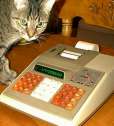Casio FM-300
| Datasheet legend
Ab/c:
Fractions calculation
AC: Alternating current BaseN: Number base calculations Card: Magnetic card storage Cmem: Continuous memory Cond: Conditional execution Const: Scientific constants Cplx: Complex number arithmetic DC: Direct current Eqlib: Equation library Exp: Exponential/log functions Fin: Financial functions Grph: Graphing capability Hyp: Hyperbolic functions Ind: Indirect addressing Intg: Numerical integration Jump: Unconditional jump (GOTO) Lbl: Program labels LCD: Liquid Crystal Display LED: Light-Emitting Diode Li-ion: Li-ion rechargeable battery Lreg: Linear regression (2-var. stats) mA: Milliamperes of current Mtrx: Matrix support NiCd: Nickel-Cadmium recharg. batt. NiMH: Nickel-metal-hydrite rech. batt. Prnt: Printer RTC: Real-time clock Sdev: Standard deviation (1-var. stats) Solv: Equation solver Subr: Subroutine call capability Symb: Symbolic computing Tape: Magnetic tape storage Trig: Trigonometric functions Units: Unit conversions VAC: Volts AC VDC: Volts DC |
| ||||||||||||||||||||||||||||||||||||||||||||||||||||||||
 What a delightful find! For the first time in years, I discovered a truly unique programmable calculator on eBay, not like any I have previously seen.
What a delightful find! For the first time in years, I discovered a truly unique programmable calculator on eBay, not like any I have previously seen.
The Casio FM-300 is a small, folding style calculator that looks rather unassuming at first: indeed, it looks like a basic 4-function calculator with square root.
But look more closely on the right-hand side. Are those touch keys? Is that a program run/write key? Three program areas? Even some rudimentary editing capability?
Indeed that's precisely what those buttons are. Which makes the FM-300 one of the rarest kinds of programmables out there: a programmable calculator that is not a full scientific calculator.
The FM-300 is called a "formula memory" calculator, but it really isn't formula programmable. Enter the program "2+3×5=" and the result you get is 25; clearly, the "formula" is just a sequence of keystrokes.
Nonetheless, even in the absence of higher mathematical functions, this calculator is capable enough to store a small program that uses Stirling's formula to compute the factorial/Gamma function of its argument:
MR x2 1/x ÷ 3 . 5 − 3 0 1/x ÷ MR x2 + 1 2 1/x ÷ MR + 1 × (MR ÷ 2 . 7 1 8 2 8 1 8 xy MR) × ( 2 × π × MR ) √ =
To run the program, just store it in, e.g., P1, then store the argument in the calculator's memory and press P1 in run mode. Alternatively, replace all occurrences of MR with A in the above, and allow the calculator to prompt for the value of the variable A.


